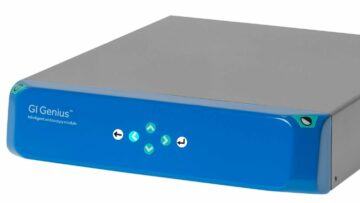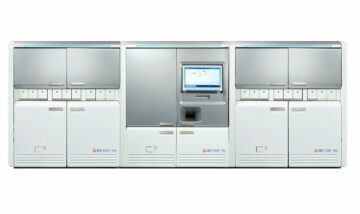
Technological developments in healthcare are constantly changing the way medical diseases are identified, tracked, and treated.
The use of AI in healthcare diagnostics is one of these breakthroughs that has the most potential to revolutionise the field.
Furthermore, the investment in remote monitoring devices highlights the rising demand for these technologies, as suggested by leading data and analytics company GlobalData‘s prediction that the market for remote patient monitoring devices will reach $760m by 2030.
In the same way, the AI market is expected to grow from $93bn in 2023 to more than $908.7bn in 2030, indicating the importance of AI and machine learning for healthcare diagnostics in the future.
These patterns point to a growing industry that is ready for investment and innovation, with AI-driven solutions in an ideal position to revolutionise healthcare delivery.
One such area where AI is making significant strides is in the diagnosis and management of specific medical conditions such as scoliosis.
Access the most comprehensive Company Profiles on the market, powered by GlobalData. Save hours of research. Gain competitive edge.

Your download email will arrive shortly
We are confident about the unique quality of our Company Profiles. However, we want you to make the most beneficial decision for your business, so we offer a free sample that you can download by submitting the below form
By GlobalData
A Canadian company, Momentum Health, has made significant advancements in the management of scoliosis with the introduction of its AI-based app Momentum Spine.
Previously, this type of care was dependent on X-rays for monitoring and quantification.
This noninvasive method allows for more proactive and individualised patient care in addition to improving accessibility.
With the use of 3D imaging and AI, the user can record a video with their mobile device, and the app will use that footage to create a 3D model of the torso.
Along with real-time measurements, the Momentum Spine app offers plumb shift, trunk shift, shoulder symmetry, waist asymmetry, and a comprehensive asymmetry map.
The app was approved by the US Food and Drug Administration in February 2024.
Likewise, the SQUIRREL module developed by ImageBiopsy Lab highlights the significance of consistency and dependability in the evaluation of scoliosis, underscoring the potential of AI in treating particular medical conditions.
In conclusion, these technologies ultimately aim to improve patient outcomes by enabling healthcare providers to make well-informed decisions more quickly and efficiently through the provision of real-time measurements and predictive analytics.
Furthermore, these tools’ noninvasiveness may lessen the need for conventional diagnostic techniques, saving money and improving patient outcomes.
- SEO Powered Content & PR Distribution. Get Amplified Today.
- PlatoData.Network Vertical Generative Ai. Empower Yourself. Access Here.
- PlatoAiStream. Web3 Intelligence. Knowledge Amplified. Access Here.
- PlatoESG. Carbon, CleanTech, Energy, Environment, Solar, Waste Management. Access Here.
- PlatoHealth. Biotech and Clinical Trials Intelligence. Access Here.
- Source: https://www.medicaldevice-network.com/analyst-comment/ai-scoliosis-diagnosis-role/
- :has
- :is
- :where
- 11
- 2023
- 2024
- 2030
- 3d
- 7
- 8
- 9
- a
- About
- accessibility
- addition
- administration
- advancements
- AI
- AI in Healthcare
- aim
- allows
- an
- analytics
- and
- app
- approved
- ARE
- AREA
- arrive
- article
- AS
- asymmetry
- below
- beneficial
- breakthroughs
- business
- by
- CAN
- Canadian
- care
- changing
- company
- competitive
- comprehensive
- conclusion
- conditions
- confident
- consistency
- constantly
- conventional
- create
- Creative
- credit
- data
- decision
- decisions
- delivery
- Demand
- dependent
- developed
- developments
- device
- Devices
- diagnosis
- diagnostic
- Diagnostics
- diseases
- download
- drug
- Edge
- efficiently
- enabling
- end
- evaluation
- expected
- February
- field
- food
- Food and Drug Administration
- For
- form
- Free
- from
- future
- Gain
- GlobalData
- Grow
- Growing
- Health
- healthcare
- highlights
- HOURS
- However
- HTTPS
- ideal
- identified
- Imaging
- importance
- improve
- improving
- in
- indicating
- industry
- Innovation
- Introduction
- investment
- ITS
- jpg
- lab
- leading
- learning
- machine
- machine learning
- made
- make
- Making
- management
- map
- Market
- May..
- measurements
- medical
- method
- Mobile
- mobile device
- model
- module
- Momentum
- money
- monitoring
- more
- most
- Need
- of
- offer
- Offers
- on
- ONE
- our
- Our Company
- outcomes
- particular
- patient
- patient care
- patient monitoring
- patterns
- plato
- Plato Data Intelligence
- PlatoData
- Point
- position
- potential
- powered
- prediction
- predictive
- Predictive Analytics
- Proactive
- Profile
- Profiles
- providers
- provision
- quality
- quantification
- quickly
- reach
- ready
- real-time
- record
- remote
- research
- rising
- Role
- same
- sample
- Save
- saving
- shift
- shutterstock
- significance
- significant
- So
- Solutions
- specific
- start
- strides
- submitting
- such
- symmetry
- techniques
- Technologies
- than
- that
- The
- The Future
- their
- These
- this
- Through
- to
- treated
- treating
- type
- Ultimately
- unique
- us
- US Food
- use
- User
- via
- Video
- want
- was
- Way..
- we
- will
- with
- you
- Your
- zephyrnet












